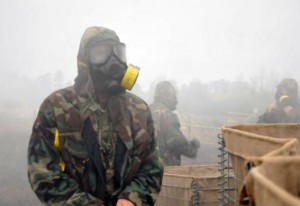By Kevin Baron  Monday, September 24, 2012
Monday, September 24, 2012 
![]() Share
Share
Cross-posted from Foreign Policy
The Pentagon does not have a clear idea of how adversaries could misuse modern biotechnology and chemical advances, according to the Defense Department’s chief chemical and biological defense official.
It turns out the Pentagon can move people faster than the speed of sound but not necessarily faster than the speed of biotechnology developments.
Gerald Parker, deputy assistant to the secretary of defense for chemical and biological defense, told the E-Ring in an interview in his fifth-floor Pentagon office that he is reexamining the department’s sizable network of laboratories, Army commands, and DOD offices tasked with the work of chemical, biological, radiological and nuclear (CBRN) protection.
“The pace of the scientific development is so rapid, and trying to understand where adversaries may try to use that advancement in, say, biotechnology, synthetic biology, genetic engineering, how it may be misused, is what we have to try to anticipate,” he said. That includes, states, terrorists — anyone. “And that’s where we don’t have a good crystal ball.”
Parker manages the back-end of these defenses, the science, the labs, the development, and recently commissioned the National Research Council to help recommend where to start. The NRC provided him a tall list, including building a basic framework to evaluate their work and better collaboration across DOD agencies.
“Bold moves are needed,” the report concluded, “to break the current stagnation that permeates the chemical and biological [science and technology] and acquisition environment. Tweaking the management or refocusing a few projects will not be sufficient.”
But it’s not a new concern. Congress created Parker’s office, long before he arrived, in the early 1990s to oversee an unwieldy network. The current assessment, Parker insisted, is a “natural evolution” to meet changing threats.
“It is evolving and it is changing, and that is a challenge that we face. What a decade ago may have impossible is now within the realm of feasibility for bad actors, to use, say, enhanced agents or new agents from a chemical and biological domain, to cause us harm.”
Ten years ago, he said, after the Cold War there was a popular belief that “advances in sciences all are going to be used for good and to help mankind.” Not anymore.
“A decade ago we still had a fairly prescribed threat list, and what are some of the pathogens or the chemicals that we need to worry about,” he said, and some are still the threats of today. “But as we evolve to the future – how will technology be misused? And that’s what we have to turn some attention to.”
“The intelligence community has a hard, hard, hard challenge,” he said. The Pentagon knows today’s threats, he said, but not enough about what could come in the future. “Our job is to try to anticipate that better.”
Now Parker wants “much more flexibility” for the Pentagon to develop countermeasures, especially in preparedness for bio-terrorism and infectious diseases. “There really is no hard and fast line between those,” he said.
For example, Parker wants DOD to move away from vaccines that use, he argued, “the one drug, one bug approach.” The fix is to have a “technology platform”– remember we’re talking about living things here — able to carry the immunization components of many diseases or pathogens, not just one, such as with the current anthrax vaccine.
Beyond that, DOD needs better ability to scale-up drug and vaccine production to national security levels, and Parker is pushing for a specific network of contracts, acquisitions and close partnerships between defense laboratory and private scientists and biotechnology companies. Parker also is pushing to fast-track past some FDA guidelines that slow vaccine production, a problem he said has caused a “gap” in biodefense.
“We have a plague vaccine in development, we have a botilinum vaccine in development – they’re not licensed yet. Those are gaps that we want to close by having a fully-licensed vaccine against those two threats that have been in development.”
But, he said, “It takes a long time to develop a vaccine…. We want to close those gaps that are already in phase 2 clinical trials and make sure they get across the goal line.”
Additionally, he is promoting “bio-security” practices domestic with non-defense U.S. agencies and international partners.
“We have to worry about state actors and non-state actors,” he said, of his Pentagon office. Especially, he said, “Making sure bad actors don’t have access to dangerous pathogens.” So DOD is getting more involved in beefing up detection of accidental or intentional outbreaks to security breaches and safe bio-containment at laboratories around the globe.
To get started, Parker said he’s going to incorporate some of National Research Council recommendations into his own internal review.